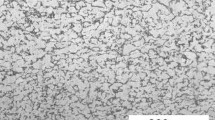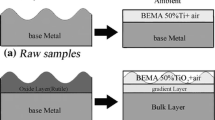Abstract
The oxidation behavior of Ti-Si alloys (0.25, 0.5, and 1 Wt. % Si) was investigated between 550 and 700°C; in oxygen by continuous thermogravimetry for a maximum duration of about 500 hr and, in air by daily weighing for durations from a few hundred to several thousand hours. The kinetics results revealed that the presence of silicon leads to a decrease in oxidation rate which is more evident when the temperature is raised and the silicon content is increased. Morphological and structural examinations revealed that silicon modifies the internal architecture of oxide layers when compared with unalloyed titanium; in particular, reduced porosity in the layers is observed. Analysis showed that silicon is uniformly distributed in the oxide layer. However, while part of the silicon is in solid solution in the rutile, some is also precipitated as small crystals (φ <1 μm at 850°C) of SiO2, of cristobalite structure. The adherence of oxide layers to the metal substrate was measured after cooling of samples; the addition of silicon has been observed to modify, in a manner dependent on its content, the adherence of oxide layers.
Similar content being viewed by others
References
H. W. MaynorJr, and R. E. Swift,Corr. 12, 293 (1956).
P. Kofstad, K. Hauffe, and H. Kjollesdal,Acta Chem. Scand. 12, 239 (1958).
D. A. Sutcliffe,Met. Treat. Drop. Frog. 21, 191 (1954).
D. A. Sutcliffe,Rev. de Métal. 8(51), 524 (1954).
R. Kieffer, F. Benesovsky, H. Nowotny, and H. Schachner,Z. Metallkol. 44, 242 (1953).
G. P. Nadutenko, S. A. Gorbunov, I. S. Anitov, and V. P. Teddorovich,Review of Metal Literature (ASM, Metals Park, Ohio, 1967), Vol. 540, p. 243.
M. Raffy, Thesis, ENSC Paris (1981).
C. J. Rosa,Oxid. Met. 17(5-6), 359 (1982).
Ogawa et coll.,Nippon Kinzoku Gak-Shi 21, 410 (1957).
A. Abba, A. Galerie, and M. Caillet,Ann. Chim. Fr. 4, 15 (1979).
A. Gannouni, A. Galerie, and M. Caillet,Ann. Chim. Fr. 8, 191–201 (1983).
A. M. Chaze and C. Coddet,Oxid. Met. 21(3/4), 205 (1984).
E. A. Garcia, Thesis, Orsay (1974).
A. Dubertret, Thesis, Paris (1970).
W. W. Smeltzer, R. R. Haering, and J. S. Kirkaldy,Acta Metallurgica 9, 880 (1961).
S. Matsunaga, and T. Homma,Oxid. Met. 10(6), 361 (1976).
Alford et al.,Materials Science and Technology 2, 333 (1968).
P. Kofstad,Non-stoechiometry, Diffusion and Electrical Conductivity in Binary Metal Oxide (Wiley, New York, 1973).
M. Dechamps and P. Lehr,J. Less-Comm. Met. 56, 193 (1977).
G. M. Crosbie,J. of Solid State Chem. 25, 367 (1978).
M. G. Harwood,Special Ceramics (1964), P. Popper, ed. (Academic Press, London, 1965).
Author information
Authors and Affiliations
Rights and permissions
About this article
Cite this article
Chaze, A.M., Coddet, C. Influence of silicon on the oxidation of titanium between 550 and 700°C. Oxid Met 27, 1–20 (1987). https://doi.org/10.1007/BF00656726
Received:
Revised:
Issue Date:
DOI: https://doi.org/10.1007/BF00656726




